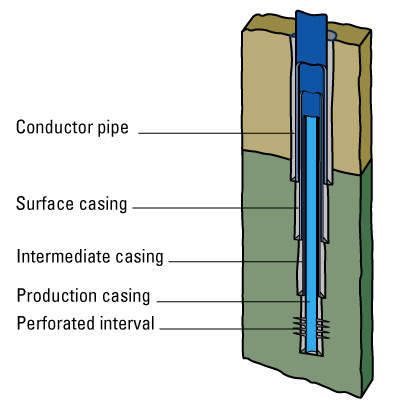Once a well has been drilled, if it is to become a production well, the well must undergo completion. While drilling a well cuts through the rock formations and allows drilling engineers to reach the reservoir below, the raw sides of the well cannot support themselves. Similar to the bones of your spine protecting the spinal cord, casing is tubing that is set inside the drilled well to protect and support the wellstream.
In addition to providing stabilization and keeping the sides of the well from caving in on themselves, casing protects the wellstream from outside contaminants, as well as any fresh water reservoirs from the oil or gas that is being produced.
Also known as setting pipe, casing a well involves running steel pipe down the inside of a recently drilled well. The small space between the casing and the untreated sides of the well is filled with cement to permanently set the casing in place.
Casing A Well
The casing is fabricated in sections, or joints, that are usually about 40 feet long and screwed together to form longer lengths of casing, called casing strings. Each end of the casing joint has male threads that are protected by cap called a thread protector until the casings are ready to be jointed. Then, a collar or coupling, composed of a short cylindrical steel pipe that is slightly larger in diameter than the joints and also has female threads, is used to connect the two male joint ends. A thread compound is used on the two ends to ensure a tight seal.
Casing is run from the rig floor, connected one joint at a time by casing elevators on the traveling block and stabbed into the previous casing string that has been inserted into the well. Hanging above the drill floor, casing tongs screw each casing joint to the casing string.
Casing is run into the well and officially landed when the weight of the casing string is transferred to the casing hangers, which are located at the top of the well and use slips or threads to suspend the casing in the well.
A rounded section of pipe with an open hole on the end, a guide shoeis connected to the first casing string to guide the casing crew in running the casing into the well. Additionally, the outside of the casing has spring-like centralizers attached to them to help position in casing string in the center of the well.
After running the casing and before the cementing the well, a useddrill bit is inserted into the well via a drillstring, and drilling fluid is then circulated for a certain amount of time to remove any remaining cuttings from the well. Also wall scratchers are dispatched into the well to remove any filter cake that may have formed on the sides of the well.
A cement slurry is then pumped into the well and allowed to harden to permanently fix the casing in place. After the cement has hardened, the bottom of the well is drilled out, and the completion process continues.
Casing Programs
Sometimes the well is drilled in stages called a casing program. Here, a well is drilled to a certain depth, cased and cemented, and then the well is drilled to a deeper depth, cased and cemented again, and so on. Each time the well is cased, a smaller diameter casing is used.
The widest type of casing is called conductor pipe, and it usually is about 30 to 42 inches in diameter for offshore wells and 16 inches in diameter for onshore wells. The next size in casing string is thesurface casing, which can run several thousand feet in length.
In some wells, protection or intermediate casing is run to separate challenging areas or problem zones, including areas of high pressure or lost circulation.
The last type of casing string that is run into the well, and therefore the smallest in diameter, is the production or oil string. The oil string is run directly into the producing reservoir.
Casing Alternatives
In an effort to save money, sometimes a liner string is run into the well instead of a casing string. While a liner string is very similar to casing string in that it is made up of separate joints of tubing, the liner string is not run the complete length of the well. A liner string is hung in the well by a liner hanger, and then cemented into place.




No comments:
Post a Comment